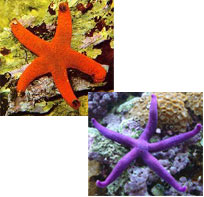Echinoderms: Part 4 - Sea Stars (Asteroidea)
Michael Paletta - Guest Author Just as radial symmetry is most noticeable in sea stars, sea stars are also the most well known of all echinoderms. Sea stars live in all oceans and in virtually all zones within the reef. In the Indo-Pacific alone there are over 200 species of sea stars, in 60 genera, and in all of the oceans there are over 1800 species. Despite five or a multiple of five being the most common number of arms, there are many species that have arms that are not in multiples of five with arms much more numerous than we normally see, as many as 50 arms. The class Asteroidea is not limited just to simple sea stars, but also include the cushion stars, horned sea stars, and pincushion stars. Sea stars have distinct upper and lower portions. On the underside of each sea star is the mouth along with a distinct cleft through which food is moved to the mouth. This cleft and mouth is referred to as the oral disk. Some sea stars do not have a separate opening for removing waste and as such, their "mouths" act as both the site for the import of food and the export of waste materials.
There are several predatory starfish that should not be kept. The Crown-of-Thorns, infamous for consuming large portions of the Great Barrier Reef in recent years, is probably the best-known example. However, a more problematic predatory sea star is the small sea star of the genus Asterina, introduced to many reef aquariums in recent years. This tiny sea star is usually no bigger than 1 inch across and seemingly has two color varieties. The white or gray variety is usually a harmless algae eater that consumes microalgae from the glass and live rock. However, there is another similar looking sea star that is mottled red, pink or green that feeds aggressively on stony and in some instances soft corals. This pest has become a frequent hitchhiker on Indo-Pacific live rock and corals. They can grow rapidly to a population that can decimate stony coral colonies in a closed system. All new coral or live rock additions should be carefully examined for these sea stars and removed immediately if found. Part 4 of 8. Continue reading:
Biography Michael Paletta is the author of two books, "The Modern Marine Aquarium" and "Ultimate Reefs," and has acted as a consultant with the National Aquarium in Baltimore and the Pittsburgh Zoo Aquarium. |
||||||||
|
|


 Most sea stars are rather specialized feeders, feeding on particular food items but should the need arise many can become omnivorous general feeders. The most desirable varieties to have in a reef aquarium are either the detrivores or the algae eaters. These include members of the genera
Most sea stars are rather specialized feeders, feeding on particular food items but should the need arise many can become omnivorous general feeders. The most desirable varieties to have in a reef aquarium are either the detrivores or the algae eaters. These include members of the genera
